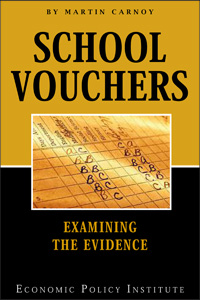
Click here to order
This book’s executive summary and introduction are available in Adobe Acrobat PDF format![]()
Executive Summary
School vouchers have been in the limelight for a decade. The basic argument is that giving parents public funds to send their children to private schools will stimulate innovation and competition among schools. Although vouchers lack broad public support, parents in low-income inner cities are more likely to favor alternatives to traditional public education, and this interest has stimulated small pilot programs in a few urban school districts. Such programs have the potential to inform public debate about vouchers’ strengths and weaknesses, but they have been evaluated mainly by researchers who openly and actively support vouchers. Yet the media tend to report results from these analyses without necessary caveats and alternative views. Now that the push for vouchers has reached the federal government through President Bush’s education initiative, the urgency for a balanced perspective has become more important than ever.
Do school vouchers improve student performance? A review of the evidence finds that vouchers’ effects on student achievement are almost certainly smaller than claimed by pro-voucher researchers. Although programs in many cities were designed to be like randomized-trial medical experiments—with high validity and reliability—common problems in implementation may have compromised validity and produced misleading results. Moreover, the results are marked by broad inconsistencies across grades, academic subjects, and racial groups.
Recent highly publicized research involving Florida schools also highlights the difficulty in attributing test score gains to vouchers, since many of these programs involve not only vouchers but also school grading systems and others variables at the same time. The same researchers who found large effects from earlier voucher programs also found large voucher effects in Florida. But a closer look reveals that most of the gains could have been caused by the school grading system, not vouchers. In three states with school grading systems—Texas, North Carolina, and Florida before vouchers—lowperforming schools (sometimes referred to as “F” schools) produced gains quite similar to those of the Florida voucher program. Thus, the “scarlet letter” effect from identifying low-performing schools is as plausible an explanation for the test score gains as is the voucher threat.
Identifying the effects of programs is a challenging task, especially for vouchers. As the evidence slowly comes in, a balanced analysis suggests that voucher effects may exist, but they are significantly smaller than voucher proponents would have the public and the media believe.
